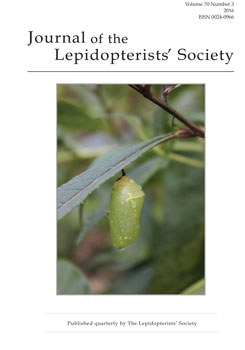Adelpha cocala Cramer (Lepidoptera: Nymphalidae: Limenitidinae) has six subspecies (Adelpha cocala caninia Fruhstorfer, Adelpha cocala cocala Cramer, Adelpha cocala didia Fruhstorfer, Adelpha cocala lorzae Boisduval, Adelpha cocala orellanae Neild, and Adelpha cocala riola Fruhstorfer), which are found in Brazil, Bolivia, Colombia, Guatemala, Peru, Suriname, Venezuela, and from Honduras to Panama (Fruhstorfer 1915, Willmott 2003b). The wingspan of these subspecies is around 50 mm (Willmott 2003a). Its larvae feed on Alseis spp., Calycophyllum spp., Chimarris spp., Chomelia spp., Genipa spp., Pentagonia spp., Psychotria spp., Sabicea spp., Uncaria spp., and Warszewiczia spp. (Rubiaceae), and Malania spp. (Olecaceae) (Beccaloni et al. 2008). Adelpha cocala didia occurs in the Brazilian states of Bahia, Espírito Santo, Mato Grosso, Minas Gerais, Santa Catarina, Rio de Janeiro, and São Paulo and in Brasília (Federal District) (Fruhstorfer 1915, Willmott 2003b). The aim of this study was to report a new host plant of A. cocala didia in the state of Minas Gerais, Brazil.
Eighty-two first-instar larvae were found defoliating leaves of 18 individuals of Triumfetta semitriloba Jacq. (Malvaceae) (around 45 cm in height) on May 2014, in secondary forest, in Viçosa, state of Minas Gerais, Brazil (20º 45′ S × 42º 50′ W and 655 m above sea level). Some branches were detached from these plants with the larvae and transferred to rearing cages (30 cm width × 30 cm length × 30 cm height) in the Laboratory for Biological Control of Insects (LCBI) of the Federal University of Viçosa (UFV) in Viçosa at 25 ± 1 °C, 12:12 (L:D) h photoperiod and 70 ± 10% R.H., where they remained until adults' emergence. Some females obtained from the collected larvae were sent to the Department of Zoology of the Federal University of Paraná (UFPR) in Curitiba, state of Paraná, Brazil, for identification by O.H.H. Mielke. They have been deposited in the entomological collection of the UFPR.
The number of pupae obtained from the collected larvae and of males and females from these pupae were evaluated. The pupa viability (number of obtained pupae ÷ number of collected larvae) × 100, adult viability (number of obtained adults ÷ number of obtained pupae) × 100, and sex ratio [number of females ÷ (number of females + number of males)] were calculated.
Seventy-two adults emerged from the 78 obtained pupae—44 females and 28 males (sex ratio= 0.61, pupa viability= 95.12% and adult viability= 92.31%). No parasitoids were observed emerging from the larvae or pupae.
This record adds a new plant genus as host of Adelpha. This addition is not surprising because Adelpha is diverse and widely distributed across North and South America (Aiello 1984, Willmott 2003b). Previously, this subspecies had been reported in the states of Bahia, Espírito Santo, Mato Grosso, Santa Catarina, Rio de Janeiro, and São Paulo, and in Brasília (Federal District) at 1.344, 402, 1.804, 1.340, 355, 645, and 946 km away from Viçosa, respectively. Larvae of Adelpha feed on around 116 species of 42 genera of 22 botanical families (DeVries 1987, Brown Jr. 1992, Diniz & Moraes 1997, Freitas et al. 2001, Freitas 2006). Adelpha cocala is known to feed on 11 plant genera in Brazil and other parts of South America (Beccaloni et al. 2008). Adelpha was found feeding on Caprifoliaceae Juss. (Dipsacales) (Willmott 2003a) and on Rubiaceae Juss. (Gentianales) (Mullen et al. 2011). In Brazil, Adelpha malea goyama Schaus feeds on Arrabidaea mutabilis Bur. and K. Schum. (Lamiales: Bignoniaceae) in the state of Paraná (Freitas 2006). Triumfetta semitriloba is host of A. cocala didia in the Brazilian state of Minas Gerais.
Acknowledgments
To Dr. Marília Cristina Duarte (Universidade de Mogi das Cruzes, Mogi das Cruzes, São Paulo State, Brazil) for identifying the plant and Dr. Olaf Hermann Hendrik Mielke for identifying the butterfly. To “Conselho Nacional de Desenvolvimento Científico e Tecnológico (CNPq)”, “Coordenação de Aperfeiçoamento de Pessoal de Nível Superior (CAPES)”, and “Fundação de Amparo à Pesquisa do Estado de Minas Gerais (FAPEMIG)” for financial support.





